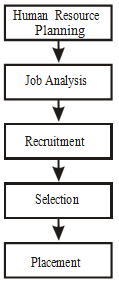Answer:
Recruitment forms a step in the process which continues with selection and ceases with the placement of the candidate. It is the next step in the procurement function, the first being the manpower planning. Recruiting makes it possible to acquire the number and types of people necessary to ensure the continued operation of the organisation. Recruiting is the discovering of potential applicants for actual or anticipated organisational vacancies.
According to Edwin B. Flippo, “Recruitment is the process of searching for prospective employees and stimulating them to apply for jobs in the organisation.”
According to Lord, “Recruitment is a form of competition. Just as corporations compete to develop, manufacture, and market the best product or service, so they must also compete to identify, attract and hire the most qualified people. Recruitment is a business, and it is a big business.”
In the words of Dale Yoder, “ Recruiting is a process to discover the sources of manpower to meet the requirements of the staffing schedule and to employ effective measures for attracting that manpower in adequate numbers to facilitate effective selection of an efficient working force.”

According to Werther and Davis, “Recruitment is the process of finding and attracting capable applicants for employment. The process beginswhen new recruits are sought and ends whentheir applications are submitted. The result is a pool of applicants form which new employees are selected.”
Dales S. Beach writes, “Recruitment is the development and maintenance of adequate manpower resources. It involves the creation of a pool of available labour upon whom the organisation can depend when it needs additional employees.”
Thus, recruitment process is concerned with the identification of possible sources of human resource supply and tapping those sources. In the total process of acquiring and placing human resources in the organisation, recruitment falls in between different sub-processes.
According to Scott, Clothier and Spriegel the need for recruitment arises out of the following situations:
- Vacancies created due to expansion, diversification, and growth of business.
- An increase in the competitive advantage of certain concerns, enabling them to get more of the available business than formerly.
- An increase in business arising from an upswing during the recovery period of a business cycle.
- Vacancies created due to transfer, promotion, retirement, termination, permanent disability or death.
- The normal population growth, which requires increased goods and services to meet the needs of the people.
- A rising standard of living, which requires more of the same goods and services as well as the creation of new wants to be satisfied.
Total Views: 87
